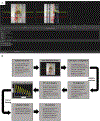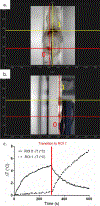HYPER: pre-clinical device for spatially-confined magnetic particle hyperthermia
- PMID: 37875265
- PMCID: PMC10624165
- DOI: 10.1080/02656736.2023.2272067
HYPER: pre-clinical device for spatially-confined magnetic particle hyperthermia
Abstract
Purpose: Magnetic particle hyperthermia is an approved cancer treatment that harnesses thermal energy generated by magnetic nanoparticles when they are exposed to an alternating magnetic field (AMF). Thermal stress is either directly cytotoxic or increases the susceptibility of cancer cells to standard therapies, such as radiation. As with other thermal therapies, the challenge with nanoparticle hyperthermia is controlling energy delivery. Here, we describe the design and implementation of a prototype pre-clinical device, called HYPER, that achieves spatially confined nanoparticle heating within a user-selected volume and location.
Design: Spatial control of nanoparticle heating was achieved by placing an AMF generating coil (340 kHz, 0-15 mT), between two opposing permanent magnets. The relative positions between the magnets determined the magnetic field gradient (0.7 T/m-2.3 T/m), which in turn governed the volume of the field free region (FFR) between them (0.8-35 cm3). Both the gradient value and position of the FFR within the AMF ([-14, 14]x, [-18, 18]y, [-30, 30]z) mm are values selected by the user via the graphical user interface (GUI). The software then controls linear actuators that move the static magnets to adjust the position of the FFR in 3D space based on user input. Within the FFR, the nanoparticles generate hysteresis heating; however, outside the FFR where the static field is non-negligible, the nanoparticles are unable to generate hysteresis loss power.
Verification: We verified the performance of the HYPER to design specifications by independently heating two nanoparticle-rich areas of a phantom placed within the volume occupied by the AMF heating coil.
Keywords: Magnetic particle hyperthermia; design verification; spatially confined heating.
Conflict of interest statement
Conflict of Interest
P.G. is a stockholder and CEO/CTO of Magnetic Insight, a company that develops and manufactures MPI scanners and MPI/MFH combination devices. R.I. is an inventor listed on several nanoparticle patents. All patents are assigned to either The Johns Hopkins University or Aduro Biosciences, Inc. R.I. is a member of the Scientific Advisory Board of Imagion Biosystems. All other authors report no other conflicts of interest.
Figures






Similar articles
-
Design and Assessment of a Novel Biconical Human-Sized Alternating Magnetic Field Coil for MNP Hyperthermia Treatment of Deep-Seated Cancer.Cancers (Basel). 2023 Mar 8;15(6):1672. doi: 10.3390/cancers15061672. Cancers (Basel). 2023. PMID: 36980560 Free PMC article.
-
Magnetic Heating Stimulated Cargo Release with Dose Control using Multifunctional MR and Thermosensitive Liposome.Nanotheranostics. 2019 Apr 19;3(2):166-178. doi: 10.7150/ntno.31164. eCollection 2019. Nanotheranostics. 2019. PMID: 31183312 Free PMC article.
-
Design and construction of a Maxwell-type induction coil for magnetic nanoparticle hyperthermia.Int J Hyperthermia. 2020;37(1):1-14. doi: 10.1080/02656736.2019.1704448. Int J Hyperthermia. 2020. PMID: 31918595 Free PMC article.
-
Recent insights in magnetic hyperthermia: From the "hot-spot" effect for local delivery to combined magneto-photo-thermia using magneto-plasmonic hybrids.Adv Drug Deliv Rev. 2019 Jan 1;138:233-246. doi: 10.1016/j.addr.2018.10.016. Epub 2018 Nov 7. Adv Drug Deliv Rev. 2019. PMID: 30414493 Review.
-
Physics responsible for heating efficiency and self-controlled temperature rise of magnetic nanoparticles in magnetic hyperthermia therapy.Prog Biophys Mol Biol. 2018 Mar;133:9-19. doi: 10.1016/j.pbiomolbio.2017.10.001. Epub 2017 Oct 6. Prog Biophys Mol Biol. 2018. PMID: 28993133 Review.
Cited by
-
Thermal dose feedback control systems applied to magnetic nanoparticle hyperthermia.Int J Hyperthermia. 2025 Dec;42(1):2491519. doi: 10.1080/02656736.2025.2491519. Epub 2025 Apr 27. Int J Hyperthermia. 2025. PMID: 40289252
-
Ranking Magnetic Colloid Performance for Magnetic Particle Imaging and Magnetic Particle Hyperthermia.Adv Funct Mater. 2025 Jan 9;35(2):2412321. doi: 10.1002/adfm.202412321. Epub 2024 Oct 18. Adv Funct Mater. 2025. PMID: 39882193 Free PMC article.
-
Imaging-guided precision hyperthermia with magnetic nanoparticles.Nat Rev Bioeng. 2025 Mar;3(3):245-260. doi: 10.1038/s44222-024-00257-3. Epub 2024 Nov 7. Nat Rev Bioeng. 2025. PMID: 40260131 Free PMC article.
-
Magnetic particle imaging resolution needed for magnetic hyperthermia treatment planning: a sensitivity analysis.Front Therm Eng. 2025;5:1520951. doi: 10.3389/fther.2025.1520951. Epub 2025 Feb 16. Front Therm Eng. 2025. PMID: 40303353
-
Magnetic Particle Imaging-Guided Thermal Simulations for Magnetic Particle Hyperthermia.Nanomaterials (Basel). 2024 Jun 20;14(12):1059. doi: 10.3390/nano14121059. Nanomaterials (Basel). 2024. PMID: 38921935 Free PMC article.
References
-
- Attaluri A; Kandala SK; Zhou HM; Wabler M; DeWeese TL; Ivkov R Magnetic nanoparticle hyperthermia for treating locally advanced unresectable and borderline resectable pancreatic cancers: the role of tumor size and eddy-current heating. International Journal of Hyperthermia 2020, 37 (3), 108–119. DOI: 10.1080/02656736.2020.1798514. - DOI - PMC - PubMed
-
- Sharma A; Ozayral S; Caserto JS; ten Cate R; Anders NM; Barnett JD; Kandala SK; Henderson E; Stewart J; Liapi E; et al. Increased uptake of doxorubicin by cells undergoing heat stress does not explain its synergistic cytotoxicity with hyperthermia. International Journal of Hyperthermia 2019, 36 (1), 712–720. DOI: 10.1080/02656736.2019.1631494. - DOI - PMC - PubMed
-
- Johannsen M; Gneueckow U; Thiesen B; Taymoorian K; Cho CH; Waldofner N; Scholz R; Jordan A; Loening SA; Wust P Thermotherapy of prostate cancer using magnetic nanoparticles: Feasibility, imaging, and three-dimensional temperature distribution. European Urology 2007, 52 (6), 1653–1662. DOI: 10.1016/j.eururo.2006.11.023. - DOI - PubMed
-
- Maier-Hauff K; Ulrich F; Nestler D; Niehoff H; Wust P; Thiesen B; Orawa H; Budach V; Jordan A Efficacy and safety of intratumoral thermotherapy using magnetic iron-oxide nanoparticles combined with external beam radiotherapy on patients with recurrent glioblastoma multiforme. Journal of Neuro-Oncology 2011, 103 (2), 317–324. DOI: 10.1007/s11060-010-0389-0. - DOI - PMC - PubMed
Publication types
MeSH terms
Substances
Grants and funding
LinkOut - more resources
Full Text Sources
Other Literature Sources
Research Materials
